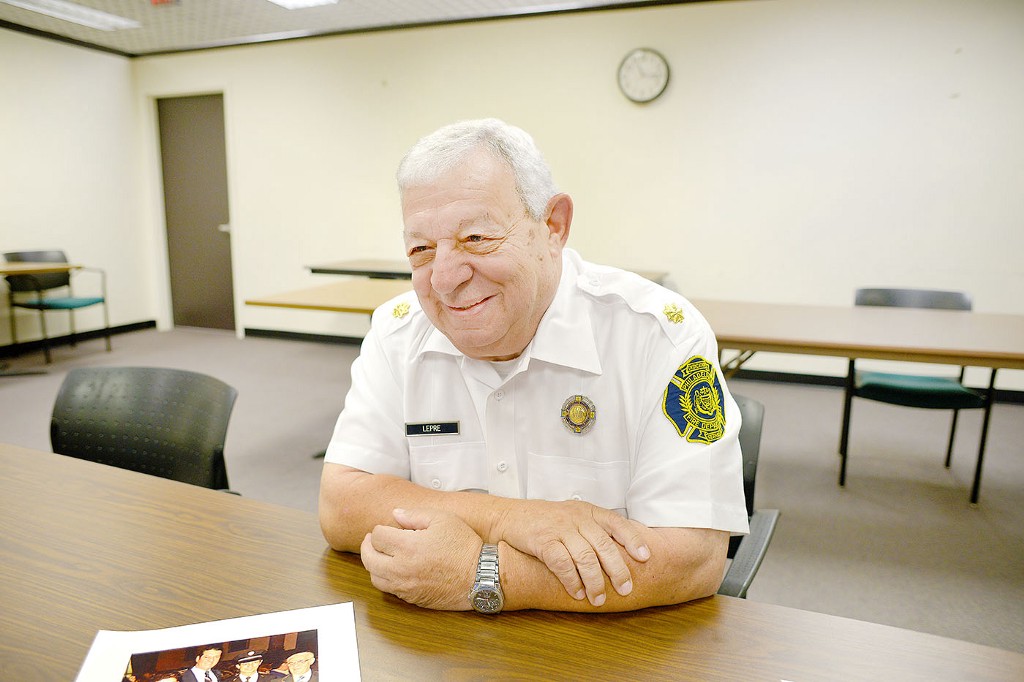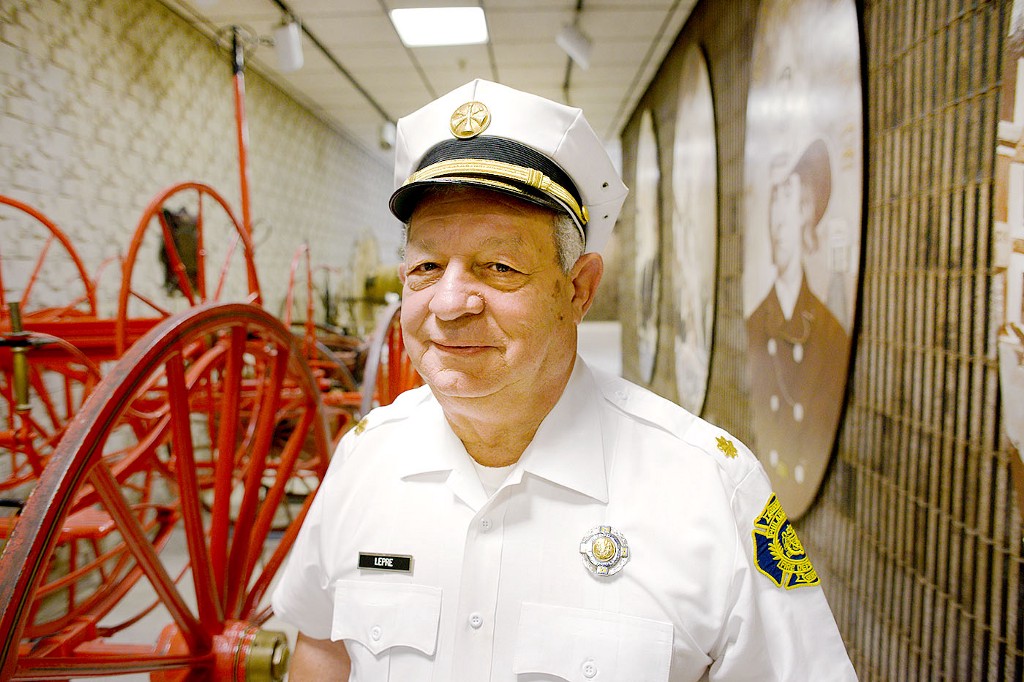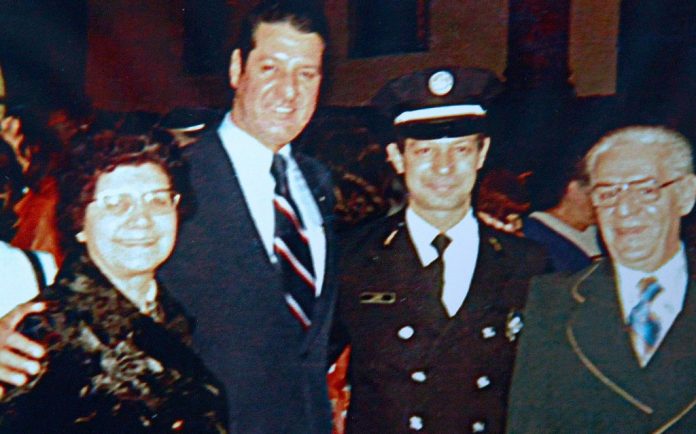Then and now: At left, Charles LePre (third from left) is shown with Fire Commissioner Joe Rizzo and flanked by his parents Jennie and Charles Sr. in a photo taken in the 1970s.
Imagine being on the job 50 years.
Charles LePre, 73, doesn’t have to imagine. The Philadelphia Fire Department battalion chief and deputy fire marshal celebrated his golden anniversary on July 22.
LePre’s work days represent a huge chunk of the Philadelphia Fire Department’s history. He’s been a firefighter more than a third of the 143 years the department has existed as a professional organization. It was all volunteer until 1870.
On the job since 1963, LePre has fought or investigated some of the city’s biggest fires — the nine-alarm Roosevelt Paper Box blaze at Aramingo and Cumberland in 1968, and two mid-’70s Gulf Oil refinery fires in South Philly, to name just a few.
He’s seen heroism and tragedy.
And close shaves.
He was among those battling a blaze at the multistory Normandy Hotel at 36th and Chestnut streets in 1968, he said.
“We rescued 363 people,” he said. Before the hotel burned to the ground, “We were inside looking for fire,” LePre said, “when we were ordered out.
“The hotel had a grand stairwell, and I’m on the mezzanine when an elevator crashed down,” LePre said in an Aug. 1 interview.
He blinked and he was out of the building and across the street.
“I could move in those days,” he said.
A HALF-CENTURY AGO
When the 23-year-old LePre started on the job five years before that fire, the average American home cost $12,650. The average income was about $5,800. A loaf of bread was 22 cents, and gasoline was 29 cents per gallon.
Jim Tate was mayor. Six other men would be elected the city’s chief executive as LePre’s career advanced from firefighter to battalion chief. He’s served under eight fire commissioners.
In other words, LePre has a lot of firefighting experience.
“He knows what he’s doing,” said Joe Schulle, president of Local 22 of the International Association of Fire Fighters. “He has the air of confidence and know-how.”
Schulle, a battalion chief, said he has known LePre more than 20 years, almost his entire career. “I worked for him. He was a battalion chief and I was a lieutenant” in the late 1990s, Schulle said in a phone interview Monday.
There might be a few other firefighters in the last 100 years who have stayed on the job for a half-century, Schulle said. “But not many. The job beats you up. Most guys are thinking about retiring when they’re in their 50s.”
Over the years, LePre has seen training increase and equipment grow sophisticated. The department has specialized units to handle difficult fires and hazardous rescues. There are now high-tech listening devices that can be wormed through debris to find people buried underneath.
And bumpy streets used to be problems, the Torresdale resident said.
“We used to stand on the rear step of an engine,” he said, “and hold onto a handlebar as we went to a fire.”
The department now has a public address system to direct its men and women to fires. It used to be signal bells that tapped out locations, he said.
LePre has seen public fire alarms disappear from city street corners.
“There aren’t any left,” he said.
During the late 1960s, when buildings were being razed in and around Northern Liberties and Fishtown to make room for Interstate 95, there were two gangs who had challenged each other to see who could set the biggest fires, LePre said. Police started a special unit to investigate the fires. They identified the culprits and arrested them.
The Fire Department itself has developed special units to fight blazes and to investigate them. The Arson Task Force composed of firefighters, cops and federal agents has existed since 1990 and has been highly successful investigating fires and catching arsonists.
As a member of the fire marshal’s office, LePre has been involved in the investigation of some of the city’s most infamous blazes.
Some he can talk about. Some he can’t.
For example, he can’t go into the April 9, 2012, fire that killed Capt. Robert Neary and firefighter Daniel Sweeney because it is still being investigated.
However, he said, in the lesser-known case of arson at the California Tanning Salon on the 6500 block of Roosevelt Blvd. five years ago that did $200,000 in damages, investigators found the fire was set with gasoline. Their work led them to two suspects. One fled to Vietnam. The other was taken into custody. He had served two years when he was sentenced July 30 to an additional 15 months and five years probation.
The Arson Task Force currently is investigating a fire that burned several cars on Sandmeyer Lane in Somerton, LePre said. It’s the third case of auto arson on the industrial road, he said. In the first case, one car was burned. Nine were torched in the second. The third arson, which took place July 30, burned 24 cars.
His career circled him back to his high school. LePre graduated from Northeast High in 1957. He was a member of the last class to graduate from the school’s 7th Street and Lehigh Avenue location. The building later continued as Edison High and then Julia De Burgos Middle Magnet School. In 2011, LePre was back at the site to investigate a fire that destroyed the then-unused castle-like structure.
THE REAL WORK
Most people probably don’t have full understandings of what firefighters do, LePre said. “Everybody thinks we run around and spray water and break windows.”
Not a true picture.
“We’re very organized. We have tactics. We use strategy,” he said.
Part of fighting fires — and coming home safely — is predetermining where each engine and ladder company will be.
The first company to arrive at a fire goes to the front of the building, he said. “The second goes to the rear.” If more companies are needed, they go to the sides as they arrive.
“We try to confine a fire,” LePre said.
Blazes in high rises require different tactics, he said. The first company on the scene goes to the floor below the fire and charges pipes with water. Firefighters then use a stairwell to take hoses up to attack the blaze. They use the stairwell as shelter. Other firefighters go up through the building to search for and rescue occupants.
“Accountability is so important,” LePre said. “We have to know where our people are, know that they’re safe and get them out if we have to.”
Teamwork is essential.
“You have to have a sense you’re doing something all together,” he said. “You can know you can go into a burning building and get out safely.”
Firefighters have to know when to go, and they do, LePre said.
“When the signal comes to evacuate, you don’t question it,” he said.
One change that has cut civilian fire fatalities is use of smoke detectors. The department really pushes their use and gives them to residents. In the past 15 years, Philadelphia’s annual fire death toll has dropped from more than 100 to about 30, LePre said.
“And we study the 20 to 30 deaths,” he said, to figure out why they occurred and how they could have been prevented.
One thing hasn’t changed in all the years LePre has been with the PFD. Careless smoking, he said, still is the leading cause of fires. ••

Then and now: 73, recently celebrated his 50th anniversary with the Philadelphia Fire Department. MARIA POUCHNIKOVA / TIMES PHOTO

50 years on the job: Charles LePre, a Philadelphia Fire Department battalion chief and deputy fire marshal, celebrated his golden anniversary on July 22. MARIA POUCHNIKOVA / TIMES PHOTO





